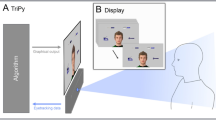Abstract
Atypical gaze coupled with impairments in communication skills in varying social situations are some of the core deficits of individuals with autism spectrum disorder (ASD). Certain aspects of social situations e.g., communicator’s Proximity and Eye-gaze are important for nurturing effective two-way social communication. Additionally, limited explicit expression of cognitive states for ASD, necessitates picking up of implicit measures e.g., gaze and physiology (not affected by communication vulnerabilities). Thus, it is important to explore variations in gaze (quantified by fixation duration) and physiology (e.g., pupil diameter, blink rate) in response to social situations embedded with variations in Proximity and Eye-gaze. In our present study, we have investigated the implication of systematically manipulated Proximity and Eye-gaze of a social communicator on one’s gaze and gaze-related physiological indices, when exposed to virtual reality based social situations. For this, we designed a usability study with 14 age-matched pairs of individuals with ASD and typically developing (TD) group. The results indicated that both Proximity and Eye-gaze can cause variations in one’s task performance, gaze pattern and gaze-related physiology for both ASD and TD groups, though by varying amounts.










Similar content being viewed by others
Explore related subjects
Discover the latest articles, news and stories from top researchers in related subjects.References
Argyle M, Cook M (1976) Gaze and mutual gaze. Cambridge University Press, Cambridge
Autism cases rise in last two decades (2017) The Times of India, (April, 2017). https://timesofindia.indiatimes.com/city/visakhapatnam/autism-cases-rise-in-last-two-decades/articleshow/57967289.cms
Bailenson JN, Blascovich J, Beall AC, Loomis JM (2003) Interpersonal distance in immersive virtual environments. Pers Soc Psychol Bull 29(7):819–833
Bakeman R (2005) Recommended effect size statistics for repeated measures designs. Behav Res Methods 37(3):379–384
Binetti N, Harrison C, Coutrot A, Johnston A, Mareschal I (2016) Pupil dilation as an index of preferred mutual gaze duration. R Soc Open Sci 3(7):160086
Cardona G, Quevedo N (2014) Blinking and driving: the influence of saccades and cognitive workload. Curr Eye Res 39(3):239–244
Chandler S, Charman T, Baird G, Simonoff E, Loucas TOM, Meldrum D, Pickles A (2007) Validation of the social communication questionnaire in a population cohort of children with autism spectrum disorders. J Am Acad Child Adolesc Psychiatry 46(10):1324–1332
Choi HH, Van Merriënboer JJ, Paas F (2014) Effects of the physical environment on cognitive load and learning: towards a new model of cognitive load. Educ Psychol Rev 26(2):225–244
Colburn A, Cohen MF, Drucker S (2000) The role of eye gaze in avatar mediated conversational interfaces. In: Sketches and applications. Siggraph’00
Coon H, Villalobos ME, Robison RJ, Camp NJ, Cannon DS, Allen-Brady K, McMahon WM (2010) Genome-wide linkage using the Social Responsiveness Scale in Utah autism pedigrees. Mol Autism 1(1):8
Data and Statistics (2018) Centers for Disease Control and Prevention. http://www.cdc.gov/ncbddd/autism/data
Diagnostic and Statistical Manual of Mental Disorders (DSM-5) (2013) American Psychiatric Pub
Didehbani N, Allen T, Kandalaft M, Krawczyk D, Chapman S (2016) Virtual reality social cognition training for children with high functioning autism. Comput Hum Behav 62:703–711
Doherty-Sneddon G, Phelps FG (2005) Gaze aversion: a response to cognitive or social difficulty? Memory Cognit 33(4):727–733
Donovan WL, Leavitt LA (1980) Physiologic correlates of direct and averted gaze. Biol Psychol 10(3):189–199
Doughty MJ (2001) Consideration of three types of spontaneous eyeblink activity in normal humans: during reading and video display terminal use, in primary gaze, and while in conversation. Optom Vis Sci 78(10):712–725
Eckstein MK, Guerra-Carrillo B, Singley ATM, Bunge SA (2017) Beyond eye gaze: What else can eyetracking reveal about cognition and cognitive development? Dev Cognit Neurosci 25:69–91
Emery NJ (2000) The eyes have it: the neuroethology, function and evolution of social gaze. Neurosci Biobehav Rev 24(6):581–604
Falck-Ytter T, Bölte S, Gredebäck G (2013) Eye tracking in early autism research. J Neurodev Disord 5(1):28
Gray C (2010) The new social story book. Future Horizons
Guestrin ED, Eizenman M (2006) General theory of remote gaze estimation using the pupil center and corneal reflections. IEEE Transactions on biomedical engineering 53(6):1124–1133
Hall ET (1996) The hidden dimension. Doubleday, New York
Hofmann SG, Smits JA (2008) Cognitive-behavioral therapy for adult anxiety disorders: a meta-analysis of randomized placebo-controlled trials. J Clin Psychiatry 69(4):621
Hong Y, Pavlou P, Wang K, Shi N (2016) On the role of fairness and social distance in designing effective social referral systems. MIS Quarterly, forthcoming; Fox School of Business research paper, no. 16–038
Jenkins R, Beaver JD, Calder AJ (2006) I thought you were looking at me: Direction-specific aftereffects in gaze perception. Psychol Sci 17(6):506–513
Keppel G (1991) Design and analysis: a researcher’s handbook, 3rd edn. Prentice Hall, Upper Saddle River
Kuchinsky SE, Ahlstrom JB, Vaden KI, Cute SL, Humes LE, Dubno JR, Eckert MA (2013) Pupil size varies with word listening and response selection difficulty in older adults with hearing loss. Psychophysiology 50(1):23–34
Kuriakose S, Lahiri U (2015) Understanding the psycho-physiological implications of interaction with a virtual reality-based system in adolescents with autism: a feasibility study. IEEE Trans Neural Syst Rehabil Eng 23(4):665–675
Lele A (2013) Virtual reality and its military utility. J Ambient Intell Humaniz Comput 4(1):17–26
Lenskiy A, Paprocki R (2016) Blink rate variability during resting and reading sessions. In: 2016 IEEE Conference on Norbert Wiener in the 21st Century (21CW), pp. 1–6
Osmani V, Carreras I, Matic A, Saar P (2014) An analysis of distance estimation to detect proximity in social interactions. J Ambient Intell Humaniz Comput 5(3):297–306
Patterson ML (1977) Interpersonal distance, affect, and equilibrium theory. J Soc Psychol 101(2):205–214
Peysakhovich V, Causse M, Scannella S, Dehais F (2015) Frequency analysis of a task-evoked pupillary response: Luminance-independent measure of mental effort. Int J Psychophysiol 97(1):30–37
Sansosti FJ, Powell-Smith KA (2008) Using computer-presented social stories and video models to increase the social communication skills of children with high-functioning autism spectrum disorders. J Posit Behav Interv 10(3):162–178
Senju A, Johnson MH (2009) Atypical eye contact in autism: models, mechanisms and development. Neurosci Biobehav Rev 33(8):1204–1214
Sibert LE, Jacob RJ (2000) Evaluation of eye gaze interaction. In: Proceedings of the SIGCHI conference on human factors in computing systems, pp. 281–288, ACM
Siegle GJ, Ichikawa N, Steinhauer S (2008) Blink before and after you think: blinks occur prior to and following cognitive load indexed by pupillary responses. Psychophysiology 45(5):679–687
Stephenson GM, Rutter DR (1970) Eye-contact, distance and affiliation: a re-evaluation. Br J Psychol 61(3):385–393
Thönes S, Hecht H (2016) How long did you look at me? The influence of gaze direction on perceived duration and temporal sensitivity. Perception 45(6):612–630
Welch KC, Lahiri U, Warren Z, Sarkar N (2010) An approach to the design of socially acceptable robots for children with autism spectrum disorders. Int J Soc Robot 2(4):391–403
Wieser MJ, Pauli P, Alpers GW, Mühlberger A (2009) Is eye to eye contact really threatening and avoided in social anxiety?—an eye-tracking and psychophysiology study. J Anxiety Disord 23(1):93–103
Zhao Y, Wang X, Goubran M, Whalen T, Petriu EM (2013) Human emotion and cognition recognition from body language of the head using soft computing techniques. J Ambient Intell Humaniz Comput 4(1):121–140
Zhou J, Sun J, Athukorala K, Wijekoon D, Ylianttila M (2012) Pervasive social computing: augmenting five facets of human intelligence. J Ambient Intell Humaniz Comput 3(2):153–166
Acknowledgements
The authors wish to thank the Pearl Special Needs Foundation, Ahmedabad, Health and Care Foundation, Ahmedabad and Tanay Foundation, Ahmedabad for helping us in enrolling the participants in our study. Also we thank Cognitive Science Research Initiative under DST, India for partially funding this research. We would also like to express our gratitude to Ministry of Electronics and Information Technology, India for offering fellowship support to the researcher under Visvesvaraya PhD Scheme.
Author information
Authors and Affiliations
Corresponding author
Additional information
Publisher’s Note
Springer Nature remains neutral with regard to jurisdictional claims in published maps and institutional affiliations.
Rights and permissions
About this article
Cite this article
Krishnappa Babu, P.R., Lahiri, U. Understanding the role of Proximity and Eye gaze in human–computer interaction for individuals with autism. J Ambient Intell Human Comput 15, 861–875 (2024). https://doi.org/10.1007/s12652-019-01175-8
Received:
Accepted:
Published:
Issue Date:
DOI: https://doi.org/10.1007/s12652-019-01175-8




